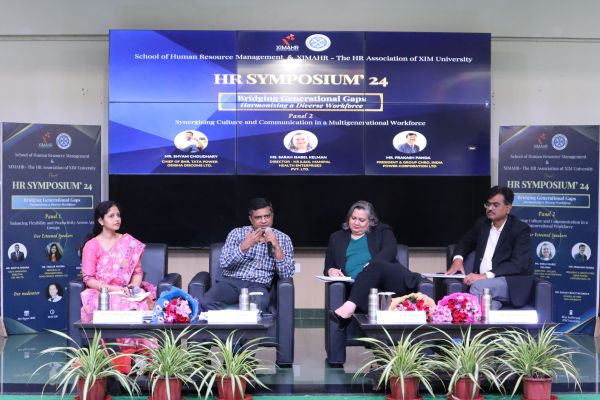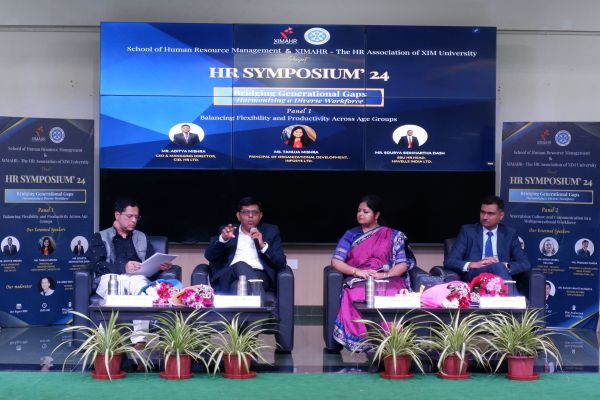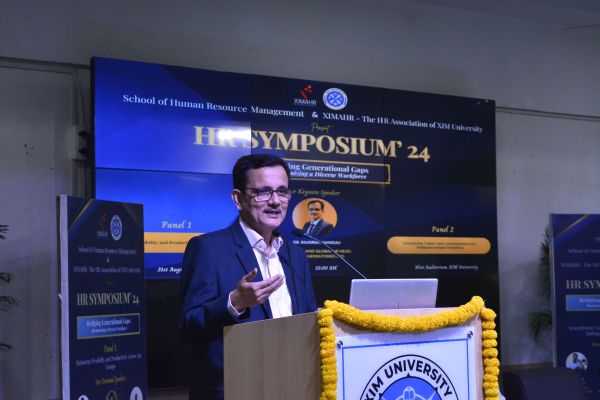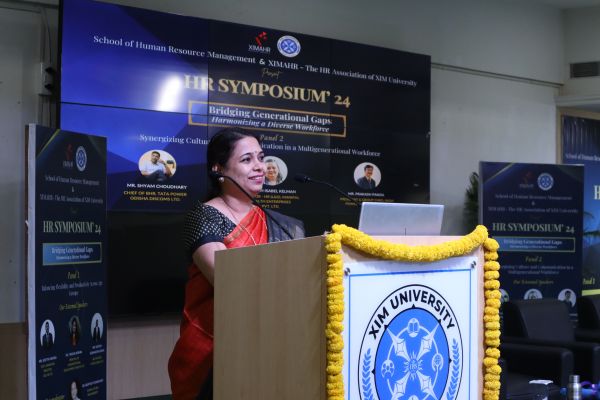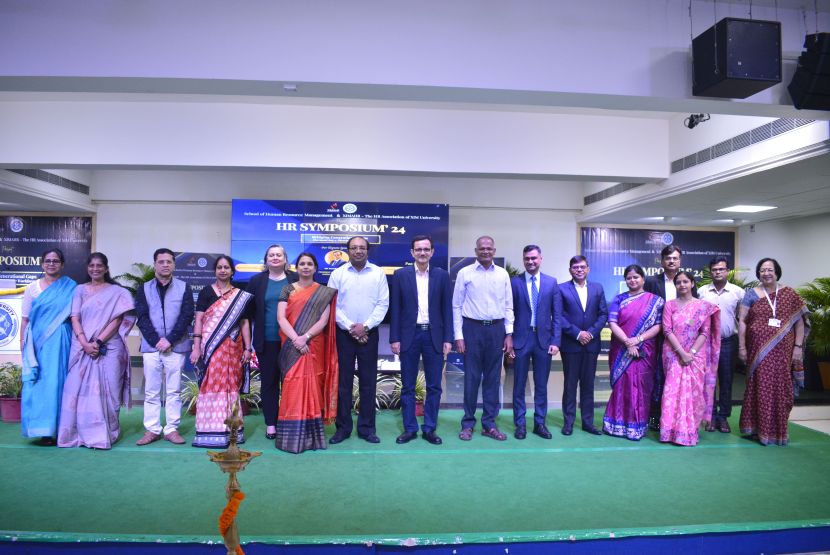Introduction -By Ayush and Vrinda (Deputy Coordinator and Coordinator)
Mousumi Padhi (Associate Dean HRM) – Presented bouquet and welcomed speakers
Topic: Bridging Generational Gaps & Harmonizing a Diverse Workforce
Lighting of lamp – by Andrew Dutta, registrar, keynote speaker, Vrinda, Shubhra Patnaik
Welcome Address by Dean Andrew Dutta
Dr Andrew Dutta highlighted the significant impact human resource professionals make in fostering an inclusive culture that embraces and values diversity. He reminded everyone that during the day, panel discussions would tackle various concerns, such as how to manage multi-generational workforces, and he encouraged the members to think out of the box on how to bridge intergenerational gaps as ways of bringing together cohesive, innovative, and resilient workforces. He showed appreciation to the panelists for sharing their expertise with them; requested active participation on the part of the students through asking questions; and he thanked his colleagues for devoting themselves to the betterment of HR. At the end, Dr. Fernandes-Este invited all present in this productive symposium to finally buckle up for a more inclusive and dynamic future.
Welcome Address by Registrar
The Registrar, while delivering the opening address at XIM University, had appealed to the students for a dire need to bridge the generational gaps in this rapid-paced world so that diversity and cohesion at workplaces can be generated. The future HR leaders must understand that innovation and adaptability are feasible in organizations by grasping the unique strengths and views of all generations: Baby Boomers, Generation X, Millennials, and Generation Z.
Key trends in human resources, like diversity, equity, inclusion, and belonging, would be directly connected to generational diversity, a balance between flexibility and productivity across generations. Dr. Fernandes-Este pointed out respect for various preferences regarding workplace and styles of communication and suggested tools like Slack and Teams to fill in the gaps. He also pointed out cross-generational mentoring and inclusive leadership for fostering collaboration and overcoming biases.
He concluded by encouraging human resource professionals to look at generational diversity as an opportunity toward growth and innovation. He advocated aligning employees with the company’s vision to increase engagement and inclusivity.
Keynote Address-
The keynote speaker at the HR symposium discussed the challenges and opportunities that arise from managing a multi-generational workforce, specifically in the context of evolving corporate environments. The speaker, representing a 50-year-old pharmaceutical company, highlighted the complexities of overseeing employees from five distinct generations: Baby Boomers, Generation X, Millennials, Gen Z, and the emerging Generation Alpha. The discussion centered on the stark contrasts in work styles, communication preferences, expectations, and the need for adaptability.
Important Points:
- Generational Differences in the Workplace:
- Each generation has distinct behaviors and expectations shaped by their socio-cultural upbringing.
- The pace of technological and cultural change has widened generational gaps, making harmonization a pressing issue.
- Evolving HR Practices:
- Traditional HR systems, including recruitment, onboarding, and performance management, must evolve to cater to younger, tech-savvy generations while still accommodating older employees.
- The recruitment process now involves more engagement through technology and social media to attract purpose-driven talent.
- Communication and Work Styles:
- Older generations are accustomed to in-person communication, while younger employees prefer digital tools like Slack.
- Presentism (physical presence at work) is being replaced by outcome-based work culture, especially after the pandemic.
- Managers must shift from micro-managing to offering guidance, fostering a culture of mentorship rather than hierarchy.
- Flexibility in Reward Systems:
- Recognition programs now offer flexible, personalized rewards. Older generations may appreciate traditional trophies or certificates, while younger employees prefer point-based rewards systems that they can use for purchases.
- Performance Management and Feedback:
- Instant feedback and continuous communication are critical for younger employees, contrasting with the older preference for formal, periodic reviews.
- Performance management systems must integrate both real-time feedback and traditional evaluation methods.
- Learning and Development:
- The demand for micro-learning (short, digital courses) has increased among younger employees, while older workers may still benefit from longer, in-person training programs.
- Organizations must provide a blend of learning methods to suit different generations.
- HR as a Change Agent:
- The speaker emphasized the critical role of HR in driving changes and fostering an inclusive environment that respects the needs of all generations.
- A key challenge is avoiding a “one-size-fits-all” approach to policies and practices, especially in compensation and benefits.
Conclusion:
The speech underscored the importance of creating an organizational culture that values flexibility, inclusivity, and understanding across generations. The success of managing a diverse workforce lies in appreciating different viewpoints, embracing technological advancements, and creating tailored systems that cater to the unique needs of each generational cohort.
Panel 1:-
Featured speakers of the panel discussion:
Mr. Aditya Mishra:
Mr. Aditya Mishra is an accomplished leader and currently serves as the Managing Director and CEO of CIEL HR Services. Prior to this, he served as the President – Staffing of Randstad India. He worked with Ma Foi Randstad for about 13 years and served as the president of the company for about 2 years. He also worked with Larsen and Turbo Limited for about 7 years. He holds an overall experience of almost 33 years and has been instrumental in building innovative HR solutions that cater to diverse sectors.
Ms. Tanuja Mishra
Ms. Tanuja Mishra, Principal of Organization Development at Infosys, brings over 20 years of experience in HR, particularly in the IT sector. She was our alum and a past member of XIMAHR. Her expertise includes leading key interventions in areas like leadership development, career pathways, and building a high-performance culture. She excels in managing complexity, change, and collaborations, aiming to set industry benchmarks through innovative HR practices in a dynamic and evolving business environment.
Mr. Sourya Sidhhartha Dash
Mr. Sourya Sidhhartha Dash is a seasoned HR leader with over 16 years of experience. He is currently serving as SBU HR Head, Havells India Ltd. Known for his strategic and innovative approach, he has been recognized as one of India’s top young HR leaders by People Matters, DDI, Jombay, and Business World. In his prior role at Philips Lighting, he managed HR operations for a business worth 2000 Crore INR across various segments. Sourya is passionate about driving organizational performance through talent development and fostering a culture of innovation and excellence.
Meet our Moderator:
Dr Arup Roy Chowdhury:
Dr Arup Roy Chowdhury works as an Assistant Professor in School of Human Resource Management, XIM University. He has substantial industry experience, having worked with Tata Steel for approximately 21 years, before transitioning to academia. In his academic role, he focuses on integrating theoretical knowledge with practical insights in HR. He has contributed significantly to research with publications in various national and international journals.
Panel Discussion: –
The agenda for the first Panel Discussion was “Balancing Flexibility & Productivity across Age Groups,” and it was moderated by Dr. Arup Roy Chowdhury, School of HRM, XIM University.
Dr. Arup Roy Chowdhury began the discussion by stating that flexibility today is about where we work and how we work. The World Economic Forum and research highlight the need for “everyday flexibility,” where employees can adjust their schedules while meeting business goals. He also mentioned that the organizations must cultivate a culture that supports flexibility, retains top talent, and enables agile management to meet this growing demand. Then, He outlined the structure of the discussion, which includes specific questions for each panelist, open-ended questions, a Q&A session with students, one success mantra for students from the panelists, and a conclusion.
The questions asked for the opening remark to all the panelists is, “Is creating workplace flexibility primarily about establishing policies and rules, or is it more about developing and sharing a vision of what flexible work looks like?”
Then, there were questions asked to each of the panelists are as follows:
- Balancing flexibility and productivity: do you think that it matters?
- Can flexible work schedules facilitate the balance between work and non-work time or lead to a flexibility paradox, which impacts productivity?
- How can workplace flexibility across the lifespan of a multi-generational workforce be ensured, and how can flexibility and efficiency in the evolving workforce be balanced?
- As an HR leader, do you think the organization should let go of multi-generational studio types to improve the employee’s value proposition?
- Does hybrid working facilitate better flexibility and improve productivity? Does workplace flexibility supercharge productivity? If this is a complex model, then what should be the approach on the shop Floor as the HR manager needs to address this complexity?
Mr. Aditya Mishra, CEO & Managing Director, CIEL HR LTD, began the discussion by highlighting the importance of flexibility and productivity in today’s context as his opening remark. He stressed that productivity is crucial in all aspects of life, including organizations and families, as it reflects one’s contributions and roles. With respect to balancing flexibility and productivity, Mr. Mishra argued that flexibility and productivity are not opposing forces but can effectively complement each other. He continued saying that HR plays a critical role in creating an environment where both can coexist by crafting policies and offering employee benefits that support productivity while accommodating flexibility. Recent research indicates that the desire for flexibility spans generations, with Gen Z exhibiting the highest need, followed by Gen Y and Gen X. This growing demand for flexibility is driven by socio-economic changes and the diversity of preferences today compared to thirty years ago. Consequently, HR must adapt by creating infrastructure that supports flexibility across various aspects, such as talent acquisition, engagement, retention, and development. Also, Flexibility now extends beyond where or when work is done, including rewards, recognition, and learning and development. Therefore, it is vital to understand that flexibility and productivity are not mutually exclusive, and HR professionals must innovate policies to maintain productivity while addressing the evolving needs of the workforce.
Mr. Mishra also addressed preconceived notions about the impact of flexibility on productivity. He cited the example of employees who resist returning to the office after relocating for personal fulfilment, arguing that physical presence in the office may only be necessary if the required output is delivered. This raises the question of whether remote work is feasible for all tasks. While some jobs, like construction, require physical presence, the assumption that most IT work can be done remotely warrants deeper reflection. He pointed out the unique value of physical interactions, such as those experienced at in-person conferences, which foster learning, relationship-building, and unstructured conversations in ways virtual meetings cannot. While not all work needs to be done physically, a balance must be struck. For example, performance appraisals tend to be more effective in person. Therefore, a hybrid approach is necessary, where physical interactions are appreciated for certain activities, and remote work flexibility is recognized for others. The goal is to create a balanced work environment that meets the nuanced work and workforce needs.
Regarding multigenerational stereotypes and employee value propositions, Mr. Mishra cautioned against stereotyping employees based on age. He noted that the diversity within age groups is significant, and assumptions based on age can lead to broad generalizations that do not reflect individual differences. He emphasized that flexibility should be embedded at the system level, not just in work hours or policies. As a company that designs HRMS, the challenge is to create flexible systems to accommodate diverse employee needs. This approach avoids age-based stereotyping and recognizes individual diversity within any age group, ultimately supporting employee engagement and productivity.
Success Mantra: Success can be achieved through embracing diverse paths and experiences, recognizing that there isn’t a single way to attain it.
Ms. Tanuja Mishra, Principal of Organizational Development, Infosys, discussed the significant changes in the IT industry, where her experience mainly lies, focusing on flexibility and productivity. The IT sector has a multi-generational workforce, with 55% of employees under age 30, 45% over 30, and only 1-2% aged 50 and above. The increasing focus on flexibility and productivity is directly linked to the evolving workforce and workplace dynamics. Flexibility includes flexible work hours, on-the-go learning opportunities, adaptable policies, and organizational change management. It also involves handling a global workforce. The hybrid work model adds complexity, where managers who prefer office work may lead remote teams they have never met in person. Organizations must build trust to ensure productivity in flexible working conditions. Surveys confirm that flexibility and productivity are not inversely proportional. Trust in employees is vital for productivity within a flexible framework. The IT industry must adapt to these changes to enhance productivity. Ms. Mishra addressed the debate on whether flexible work schedules facilitate work-life balance or create a “flexibility paradox” impacting productivity. She outlined the “ABCDE framework”: Autonomy, Balance, Culture, Digital Integration, and Engagement.
- Autonomy allows employees to choose work hours and locations
- Balance reflects the growing importance of work-life balance
- Culture is critical in ensuring that flexibility upholds productivity
- Digital Integration involves managing the shift towards digital tools
- Engagement requires HR to develop strategies to maintain enthusiasm and connection in a flexible work environment.
Ms. Mishra shared insights into recent experiences in the hybrid work environment, emphasizing that the outcome of flexibility depends on the organization’s ecosystem, culture, and management expectations. She mentioned how Infosys aimed to rekindle appreciation for the workplace by inviting alums back to the office and creatively engaging current employees by setting up kiosks in informal settings. She concluded stating that, flexibility can lead to highly engaged and productive teams but can also present challenges. Successful flexibility depends on establishing explicit cultural norms and expectations to balance flexibility and productivity for positive organizational and employee outcomes.
Success Mantra: “Make small, daily improvements to achieve significant overall transformation.”
Mr. Sourya Sidhhartha Dash, SBU HR Head, Havells India Ltd, initiated the discussion by exploring the intricate relationship between flexibility, productivity, and managing a multi-generational workforce. He addressed common misconceptions and emphasized that the belief in a direct connection between flexibility and productivity needs to be re-evaluated. Flexibility should not be linked with output levels, as productivity metrics vary widely across organizations. Today’s workplaces consist of up to five or six generational workforces with distinct work expectations and styles due to rapid technological advancements and societal changes. Managing this diverse workforce is crucial for maintaining productivity while offering the necessary flexibility for organizational success. He stressed that flexibility goes beyond policies or processes; it represents a broader cultural mindset. The traditional view that productivity can be measured solely by office hours needs to be updated, with a shift towards focusing on output and results. The pandemic has accelerated the adoption of flexible work models, increasing acceptance of remote and hybrid arrangements. This shift allows organizations to access a broader talent pool, enhancing productivity and performance.
Additionally, the environmental benefits of flexible work arrangements were highlighted, as remote and hybrid models contribute to reduced emissions and decreased urban congestion, aligning with corporate social responsibility goals. He also stated that adapting to the diverse needs of a multi-generational workforce and embracing flexibility as a cultural mindset rather than merely a productivity tool is critical. HR professionals are pivotal in navigating these changes, ensuring that flexibility supports organizational objectives while fostering a productive work environment. This includes reviewing and adapting workplace policies to support flexible arrangements, investing in HR and management training, and continuously monitoring the impact of flexibility on productivity to make informed adjustments. Implementing workplace flexibility across the lifespan for a multi-generational workforce while balancing flexibility and efficiency requires trust and empowerment. Trust between the organizations and employees addresses a significant part of the challenge, but policies and processes are still essential in recognizing the flaws of the workplace. HR and business leadership are critical in managing a multi-generational workforce, where clear and frequent communication is vital. Different generations have varied expectations shaped by socio-economic and cultural backgrounds, and so consistent and adaptive communication is more necessary. Communication must be deliberate and precise in a hybrid work model where many virtual interactions lack visual cues. Mentoring and reverse mentoring are critical strategies for promoting understanding and collaboration among different generations. Younger employees can learn from the experiences and methods of older generations through mentoring. In contrast, reverse mentoring allows seasoned professionals to gain insights into newer approaches and skills, promoting mutual growth and innovation.
Additionally, customizing benefits is essential, as a one-size-fits-all approach is no longer viable. Benefits should be adaptable to different life stages, catering to specific needs and priorities at various ages. Providing a flexible range of benefits allows employees to choose what best suits their circumstances, such as prioritizing life insurance at 40 or seeking more flexible time at 25. In summary, by integrating trust, clear communication, mentoring, and tailored benefits, organizations can effectively balance flexibility and efficiency while accommodating the diverse needs of a multi-generational workforce.
Success Mantra: Continuously adapt and revamp yourself to keep up with the rapidly changing world and diverse preferences.
Dr. Arup Roy Chowdhury concluded the panel discussion by highlighting three key takeaways:
- The first is the need to adapt to the changing work landscape.
- The second is that productivity and flexibility are not the two sides of the coin but go hand in hand.
- The third is about the changing diversity of preferences. As HR professionals, we must create an enabling structure and be open to learning. He also stated that even small changes can lead to significant improvement within an organization.
Panel 2-
Featured Speakers for Panel discussion
- Shyam Choudhury:
Mr. Shyam Choudhury is currently working as the chief of BHR, Tata Power Odisha Discoms Ltd. Having 21 years of experience in Construction, Manufacturing & Power sector, Shyam is a Strategic HR Business partner backed by rich Engineering knowledge and experience. He has developed his expertise in developing & implementing human resources strategies with complete accountability of Goal Setting, Leadership Development, Performance Management, Training & Development, Managing Workplace Diversity, Change Management and Industrial Relations.
- Sarah Isabel Kelman:
Ms. Sarah Kelman is the current L&D Manager of Manipal Health Enterprises Pvt. Ltd.
- Prakash Panda:
Currently the President and Group CHRO of India Power Corporation Ltd., Mr Prakash is an HR Transformation Leader with above 32 years of experience in Retail, Telecommunications, Power & Manufacturing (Cement, Aluminium, Synthetics) Industry in the field of HR, Quality Management & Training in Corporate /Regional/Plant Head Roles.
Meet our Moderator
Dr Subhra Pattnaik
Dr Subhra works as an Associate Professor in School of Human Resource Management, XIM University. She teaches courses such as Compensation and Reward Management, Performance Management and International Human Resource Management.
Panel Discussion
The discussion agenda for the Panel Discussion post lunch was “Synergizing Culture and Communication in a Multigenerational Workforce” and the session was moderated by Dr. Subhra Pattnaik, School of HRM, XIM University.
Dr Subhra opened the discussion by sharing stories from her own life and how communication between different generations has always been a challenge in her house, a microcosm of an organization. Talking of the generational diversity, she emphasized on difference in communication and working styles in organizations. She explained about how her expectations as a student is different from the expectations of Gen Z students. She depicted the difference in beliefs and preferences stating while the Gen X believed in getting the work done, Gen Y looked for social networks in workplaces, and Gen Z looks at techno-social networks at workplace. She thus opened the floor for discussion to the panelists from the essential industries by raising the question: “What are the biggest challenges in generational diversity and what are the methods to address it?”
Ms Sarah began the discussion by stating the importance of communication in healthcare industry. She highlighted the difference in preferred communication styles of older and younger generation. While the older generation prefers elaborative information on all topics, the younger generation looks for crisp and easily graspable information. She brought in the topic of digital communication and explained how adapting to the fast-paced changing scenarios in the communication field is necessary. To bridge the gap arising out of difference in preferences between generations, she suggested that constant interaction and a two-way communication is essential.
Mr Shyam put in a fresh perspective stating multigenerational isn’t a new thing. Further, he stated that the differentiating factor between the generations is not the knowledge in the era of AI but the diversity in experience and exposure that they bring. Differing with the subject line of the event, he puts forward that calibrating organization culture instead of synergizing would be more appropriate. The real challenges thus lie in dealing with the ‘I vs We’ mindset. Citing the example of TATA Power, he said that not the knowledge but the behavioural competencies is the differentiating factor. TATA Power focuses more on creating rewards and recognition systems for the team and not the individual. With a traditionalist approach to the topic, Mr Choudhury stated that Gen Z shouldn’t perceive itself as the knowledgeful lot in the workforce and should learn to uphold the core values of respecting one another. He concluded by highlighting that multiple generations should not be looked as a source of conflict but should be treated as complementary to each other.
Mr Prakash mentioned that the practices in talent management and organisational productivity is continuously evolving. He talked about three generations in workforce: radio generation, television generation, and internet generation. He also brought in the multigenerational context in Indian mythology like Mahabharata in which six generations were involved and questioned how did in that era synergy was created. He also put forward a local perspective stating about the excitement people in Odisha feel upon witnessing multiple generations in their household in their lifetime. Mr Prakash then highlighted one of the major causes of why handling a multigenerational workforce is more difficult today even if it existed since ages; the longevity of people is increasing. He suggested that the organizations need to gear up to build support systems to synergize each generations’ expectations and cultures. He stated that in order to achieve the goal, as the stakeholders of a company we need to focus on the individual strengths rather than focusing on the individual limitations. He concluded by emphasizing two major elements which helps in the continuous growth of an organization, retention culture and sustainability.
Conclusion
- Vote of Thanks by Mousumi Padhi
- Memento to Keynote by registrar
- Memento to registrar by Dean Andrew Dutta
- National Anthem


